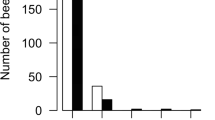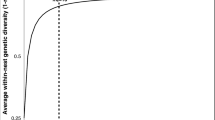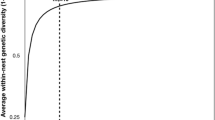Summary
Recent studies have shown that differences in patterns of task specialization among nestmate honeybee workers (Apis mellifera) can be explained, in part, as a consequence of genotypic variability. Here, we present evidence supporting the hypothesis that an individual's pattern of task specialization is affected not only by her own genotype, but, indirectly, by the genotypes of her nestmates. Workers from two strains of honey bees, one selected for high pollen hoarding, the other for low pollen hoarding, were observed in colonies of their respective parent strains and in colonies of the other strain. Worker genotype and host-colony type affected foraging activity. Workers from the high strain fostered in low-strain colonies returned with pollen on 75.6% of total foraging trips, while workers from the high strain fostered in high-strain colonies returned with pollen on 53.5% of total trips. Workers from the low strain fostered in low-strain colonies returned with pollen on 34.8% of total foraging trips while workers from the low strain fostered in high-strain colonies returned with pollen on 2.6% of total trips. Similar results were obtained in a second experiment. We suggest that workers influence the behavior of their nestmates indirectly through their effects on the shared colony environment. The asymmetry seen in the response of workers from these strains to the two types of colony environments also suggests that these genotypes exhibit different norms of reaction.
Similar content being viewed by others
References
Allard RW, Adams J (1969) The role of intergenotypic interactions in plant breeding. Proc XII Intern Congr Genet 3:349–370
Al-Tikrity WS, Benton AW, Hillman RC, Clarke WW Jr (1972) The relationship between the amount of unsealed brood in honeybee colonies and their pollen collection. J Apic Res 11:9–12
Barker RJ (1971) The influence of food inside the hive on pollen collection by a honeybee colony. J Apic Res 10:23–26
Calderone NW (1988) The genetic basis for the evolution of the organization of work in colonies of the honey-bee, Apis mellifera (Hymenoptera:Apidae). Ph.D. Dissertation. The Ohio State University, olumbus, Ohio
Calderone NW, Page RE Jr (1988) Genotypic variability in age polyethism and task specialization in the honey bee, Apis mellifera (Hymenoptera:Apidae). Behav Ecol Sociobiol 22:17–25
Calderone NW, Page RE Jr (1991) Evolutionary genetics of division of labor in colonies of the honey bee (Apis mellifera). Am Nat 138:69–92
Calderone NW, Robinson GE, Page RE Jr (1989) Genetic structure and division of labor in honeybee societies. Experientia 45:765–767
Falconer DS (1981) Introduction to quantitative genetics. Longman Inc., NY
Fewell JH, Winston ML (1990) The relationship between food stores and foraging effort in the honey been, Apis mellifera L. In: Veeresh GK, Mallik B, Viraktamath CA (eds) Social Insects and the Environment: Proceedings of the 11th International Congress of International Union for the Study of Social Insects (IUSSI), Bangalore, August 5–11, 1990. Vedams Books International, New Delhi
Filmer RS (1932) Brood area and colony size as factors in activity of pollination units. J Econ Entomol 25: 336–343
Free JB (1967) Factors affecting the collection of pollen by honeybee foragers. Anim Behav 15:134–144
Free JG, Williams IH (1971) The effect of giving pollen and pollen supplement to honeybee colonies on the amount of pollen collected. J Apic Res 10: 87–90
Frumhoff PC, Baker J (1988) A genetic component to division of labor within honey bee colonies. Nature 333:358–361
Gary NE, Lorenzen K (1976) A method for collecting the honeysac contents from honeybees. J Apic Res 15:73–76
Hedrick PW (1986) Genetic polymorphism in heterogeneous environments: a decade later. Annu Rev Ecol Syst 17:535–566
Hellmich RE II, Kulincevic JM, Rothenbuhler WC (1985) Selection for high and low pollen-hoarding honey bees. J Hered 76:155–158
Kolmes SA, Winston ML, Fergusson LA (1989) The division of labor among worker honey bees (Hymenoptera:Apidae): The effects of multiple patrilines. J Kan Entomol Sco 62:80–95
Kulincevic JM, Rothenbuhler WC, Rinderer TE (1984) Disappearing disease: III. A comparison of seven different stocks of the honey bee (Apis mellifera). Research Bulletin 1160, The Ohio State University Ohio Agricultural Research and Development Center, Wooster, OH
Lindauer M (1953a) Division of labor in the honeybee colony. Bee World 34:63–73
Lindauer M (1953b) Division of labor in the honeybee colony. Bee World 34:85–90
Lindauer M (1955) The water economy and temperature regulation of the honeybee colony. Bee World 35:67–72, 81–92, 105–111
Moritz RFA, Hillesheim E (1989) Genotypic intragroup variance and hoarding behavior in honeybees (Apis mellifera L.). Apidologie 20:383–390
Moritz RFA, Southwick EE (1987) Phenotypic interactions in group behavior of honeybee workers (Apis mellifera L.). Behav Ecol Sociobiol 21:53–57
Oster GF, Wilson EO (1978) Caste and ecology in the social insects. Princeton University Press, Princeton, NJ
Owen RE (1989) The genetics of colony level selection. In: Breed MD, Page RE (eds) Genetics and Social Evolution. Westview Press, Boulder, CO, pp 31–60
Page RE Jr (1986) Sperm utilization in social insects. Annu Rev Entomol 31:297–320
Pianka ER (1974) Evolutionary ecology. Harper and Row, NY, pp 123–125
Ribbands CR (1952) Division of labor in the honeybee community. Proc R Soc Lond B 140:32–43
Robinson GE (1985) Effects of a juvenile hormone analogue on honey bee foraging behavior and alarm pheromone production. J Insect Physiol 31:277–282
Robinson GE, Page RE (1988) Genetic determination of guarding and undertaking in honey bee colonies. Nature 333:356–358
Robinson GE, Page RE (1989a) Genetic determination of nectar foraging, pollen foraging, and nest-site scouting in honey bee colonies. Behav Ecol Sociobiol 24:317–323
Robinson GE, Page RE (1989b) Genetic basis for division of labor in an insect society. In: Breed MD, Page RE (eds) Genetics and Social Evolution. Westview Press, Boulder, CO, pp 61–80
Seeley TD (1982) Adaptive significance of the age polyethism schedule in honeybee colonies. Behav Ecol Sociobiol 11:287–293
Sekiguchi K, Sakagami SF (1966) Structure of foraging population and related problems in the honeybee, with considerations on the division of labor in bee colonies. Hokkaido Natn Agric Exp Stn Rep 69:1–63
Sokal RR, Rohlf FJ (1981) Biometry. WH Freeman and Co, NY
Wilson EO (1971) The insect societies. Belknap Press of the Harvard University Press. Cambridge, MA
Wilson EO (1987) Causes of ecological success: The case of the ants. The sixth Tansley lecture. J Anim Ecol 56:1–9
Winston ML, Katz SJ (1982) Foraging differences between cross-fostered honeybee workers (Apis mellifera) of European and Africanized races. Behav Ecol Sociobiol 10:125–129
Author information
Authors and Affiliations
Additional information
Offprint requests to: N.W. Calderone
Rights and permissions
About this article
Cite this article
Calderone, N.W., Page, R.E. Effects of interactions among genotypically diverse nestmates on task specialization by foraging honey bees (Apis mellifera). Behav Ecol Sociobiol 30, 219–226 (1992). https://doi.org/10.1007/BF00166706
Received:
Accepted:
Issue Date:
DOI: https://doi.org/10.1007/BF00166706




